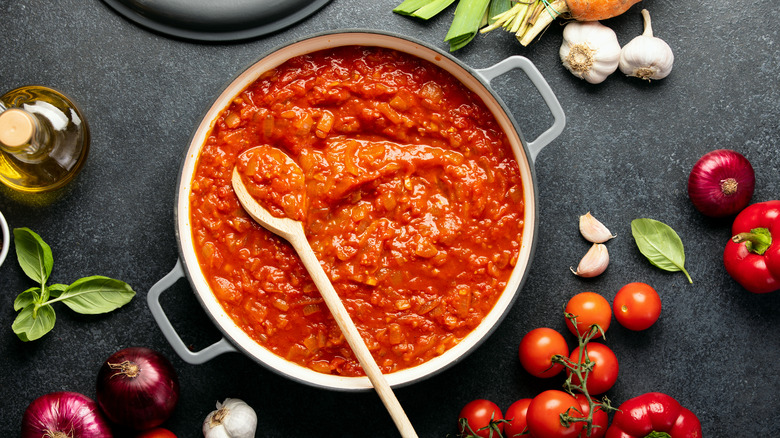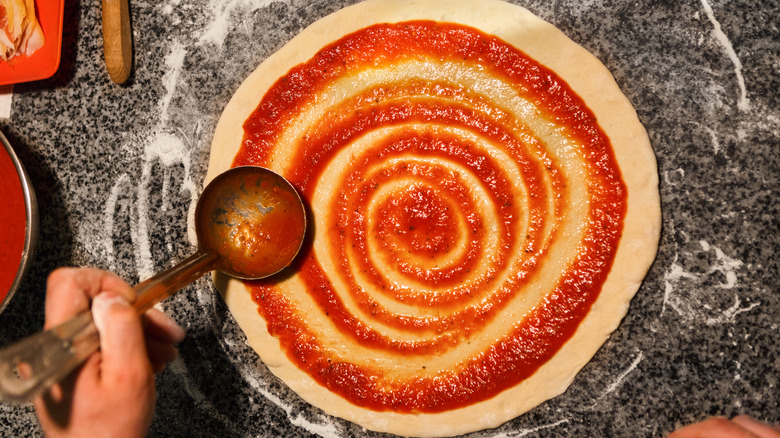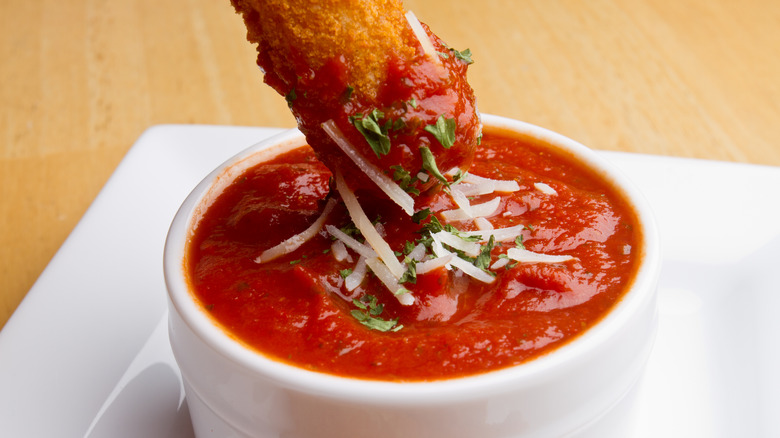Is There Really A Difference Between Pizza Sauce And Marinara?
It can be easy to slip into the idea that there is no difference between pizza sauce and marinara. There are a lot of different tomato sauces out there (it is one of the principal parts of Italian cuisine after all) and the ways the ingredients and preparation vary between each one can be very small. You might understand that arrabbiata sauce is spicy from red pepper, but what in the world is the difference between any of those other tomato sauce choices and pomodoro?
Pizza sauce seems like even more of a misnomer since you could put any number of sauces on pizza. Can't you just spread some marinara on your pie and call it a day? You can do that, of course, but pizza sauce is distinct from marinara for a reason, and your pizza won't be the same without it.
Pizza sauce and marinara differ in flavor, but it really comes down to a divergence in purpose. There are different ingredients and different final textures that you are aiming for with pizza sauce because of how it works in conjunction with the cheese and the crust. Marinara is made to stand on its own, so it has more complex flavors and takes more effort to make. Pizza sauce is just one ingredient among many, and so it needs to be simple and fresh. Both sauces can vary from recipe to recipe, but that's the fundamental divide between the two.
Pizza sauce is light and uncooked
Pizza sauce is usually a relatively basic recipe that only uses tomatoes, salt, pepper, and sometimes a few herbs. The thing that sets pizza sauce apart from marinara and most other tomato sauces is that it's usually uncooked. You want that tart and bright flavor that comes from fresh tomatoes to balance out the fatty cheese. You also have to remember that it is going to be heated in the oven, so having a sauce that is already reduced would result in it being cooked a second time, making it overdone and possibly too thick by the time the pizza is finished.
The name says it all. This is a sauce whose sole purpose is making pizza, so everything about how it's made is in service to that. The consistency of pizza sauce is also thinner than marinara. You might think this would make the pizza watery, but you should be using a light hand with your pizza sauce anyway (as little as ⅔ cup for a full 14-inch pie) so that the limited amount of uncooked sauce doesn't sog up the crust.
To make pizza sauce, it's as simple as mixing tomatoes with salt and pepper in a blender or food processor and pureeing until smooth. You can add a few basic things like garlic, herbs, and olive oil for a deeper flavor if you like. As soon as it's smooth, it's ready to be spooned onto your pizza.
Marinara sauce is thicker and more complexly flavored
Marinara sauce has a bit more going on than pizza sauce but is still pretty simple as far as tomato sauces go. In addition to the base of tomatoes, salt, and pepper, there are usually aromatics like onion and garlic, herbs like oregano or basil, and sometimes additional spices like red pepper flakes. Fats like olive oil and butter can also be added and emulsified into the sauce as it cooks. Marinara is still meant to be an easy and straightforward tomato sauce, so it only gets cooked down for a half-hour to an hour or so to thicken it and deepen the flavor.
The texture is usually on the smooth side but can be a little more chunky and rustic if you like. Marinara is meant to be a little thicker, like most cooked tomato sauces, because it needs to coat and cling to pasta. Because of how it's cooked and the deeper flavor, marinara has more uses than the one-purpose pizza sauce. Of course, it's great with pasta, where it's flavorful enough to be the centerpiece of a meal, but it can also be used as a dipping sauce or as an accompaniment to dishes like chicken parmesan. That combination of simplicity and versatility is why marinara has become so popular that it's almost interchangeable with tomato sauce.


